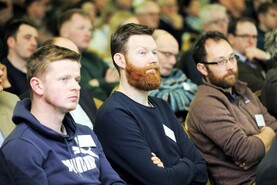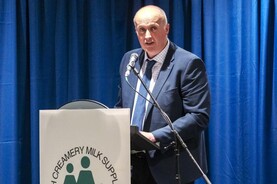At last week’s IFA AGM, Minister McConalogue outlined the “need for a mature discussion on the continued focus on additional cows” while also stating that the Department’s Ag Climatise roadmap “is based on the premise of a stable herd”.
This is a clear signal that restrictions are being considered by the Department of Agriculture. The IFA sees this as a short-sighted strategy that ignores alternative options which can achieve better outcomes.
Irish farmers fully appreciate the important role they play in helping to reach our climate ambitions.
This is evidenced by the almost €80m investment in Low Emission Slurry Spreading (LESS) in the past five years, along with the sharp uptake of protected urea, with sales more than doubling in the last 12 months.
It illustrates how adept farmers are at adopting new technologies, when underpinned by a combination of policy and appropriate funding.
From a climate change perspective, the central focus has been on methane emissions. It was encouraging to see new research on this very area being highlighted again at the Teagasc Signpost series webinar last Friday.
Scientific research on reducing methane emissions per animal is progressing rapidly. Feed additives, for example, are showing potential reductions of 30% per cow. In Ireland, we have already made progress using animal genetics and more good work is happening in this area by Teagasc and ICBF.
These solutions could deliver much more significant reductions in methane per animal by the middle of this decade.
Furthermore, how methane is accounted for in emissions calculations is also under scientific debate. The alternative global warning potential (GWP) methodology by Professor Myles Allen factors in the short-lived nature of methane in the atmosphere.
Yet, we are told it can’t be factored into international calculations until 2030. This is wrong. If the science changes, the calculations should change.
While we accept that this does not give agriculture a free pass on methane, it would give us far greater acknowledgement for even marginal reductions.
It is also worth reminding policymakers that FAO data shows increasing global demand for meat and dairy products. If we don’t produce them, they will be produced in other countries where the carbon footprint is likely to be higher. Any initiative by the Irish government to curb animal numbers in Ireland is likely to increase methane emissions globally.
It’s also highly frustrating that the debate on the climate impact of agriculture continues to focus solely on emissions. There is no recognition for the removal of carbon out of the atmosphere through sequestration.
The Government’s overall climate target is based on a NET carbon figure. So should the calculations on our farms. Ireland is behind the curve on this. But good work has been done by Devenish in Dowth, and Teagasc has plans to do a lot more through its Signpost farms. Before we start talking about “mature” debates, we need all the facts. The lazy narrative is that livestock numbers have exploded in Ireland. The reality is we had about 7.2m livestock in 2019; some 300,000 fewer than 1997. Dairy cow numbers are only now returning to levels seen pre-quota in 1984.
For over 30 years, production restrictions through milk quota, and for a time, suckler cow quotas, prevented farmers from maximising efficiencies. It discouraged the next generation from entering farming. Less than seven years on, we have policymakers trying to soften up farmers for new restrictions.
The Minister for Agriculture must show real leadership on this issue. Real alternatives are on the horizon. He is right that we need a mature discussion. The current debate focusing on cattle numbers is decidedly immature.
Read more
‘Mature discussion’ needed on dairy herd expansion – McConalogue
At last week’s IFA AGM, Minister McConalogue outlined the “need for a mature discussion on the continued focus on additional cows” while also stating that the Department’s Ag Climatise roadmap “is based on the premise of a stable herd”.
This is a clear signal that restrictions are being considered by the Department of Agriculture. The IFA sees this as a short-sighted strategy that ignores alternative options which can achieve better outcomes.
Irish farmers fully appreciate the important role they play in helping to reach our climate ambitions.
This is evidenced by the almost €80m investment in Low Emission Slurry Spreading (LESS) in the past five years, along with the sharp uptake of protected urea, with sales more than doubling in the last 12 months.
It illustrates how adept farmers are at adopting new technologies, when underpinned by a combination of policy and appropriate funding.
From a climate change perspective, the central focus has been on methane emissions. It was encouraging to see new research on this very area being highlighted again at the Teagasc Signpost series webinar last Friday.
Scientific research on reducing methane emissions per animal is progressing rapidly. Feed additives, for example, are showing potential reductions of 30% per cow. In Ireland, we have already made progress using animal genetics and more good work is happening in this area by Teagasc and ICBF.
These solutions could deliver much more significant reductions in methane per animal by the middle of this decade.
Furthermore, how methane is accounted for in emissions calculations is also under scientific debate. The alternative global warning potential (GWP) methodology by Professor Myles Allen factors in the short-lived nature of methane in the atmosphere.
Yet, we are told it can’t be factored into international calculations until 2030. This is wrong. If the science changes, the calculations should change.
While we accept that this does not give agriculture a free pass on methane, it would give us far greater acknowledgement for even marginal reductions.
It is also worth reminding policymakers that FAO data shows increasing global demand for meat and dairy products. If we don’t produce them, they will be produced in other countries where the carbon footprint is likely to be higher. Any initiative by the Irish government to curb animal numbers in Ireland is likely to increase methane emissions globally.
It’s also highly frustrating that the debate on the climate impact of agriculture continues to focus solely on emissions. There is no recognition for the removal of carbon out of the atmosphere through sequestration.
The Government’s overall climate target is based on a NET carbon figure. So should the calculations on our farms. Ireland is behind the curve on this. But good work has been done by Devenish in Dowth, and Teagasc has plans to do a lot more through its Signpost farms. Before we start talking about “mature” debates, we need all the facts. The lazy narrative is that livestock numbers have exploded in Ireland. The reality is we had about 7.2m livestock in 2019; some 300,000 fewer than 1997. Dairy cow numbers are only now returning to levels seen pre-quota in 1984.
For over 30 years, production restrictions through milk quota, and for a time, suckler cow quotas, prevented farmers from maximising efficiencies. It discouraged the next generation from entering farming. Less than seven years on, we have policymakers trying to soften up farmers for new restrictions.
The Minister for Agriculture must show real leadership on this issue. Real alternatives are on the horizon. He is right that we need a mature discussion. The current debate focusing on cattle numbers is decidedly immature.
Read more
‘Mature discussion’ needed on dairy herd expansion – McConalogue






 This is a subscriber-only article
This is a subscriber-only article











SHARING OPTIONS: